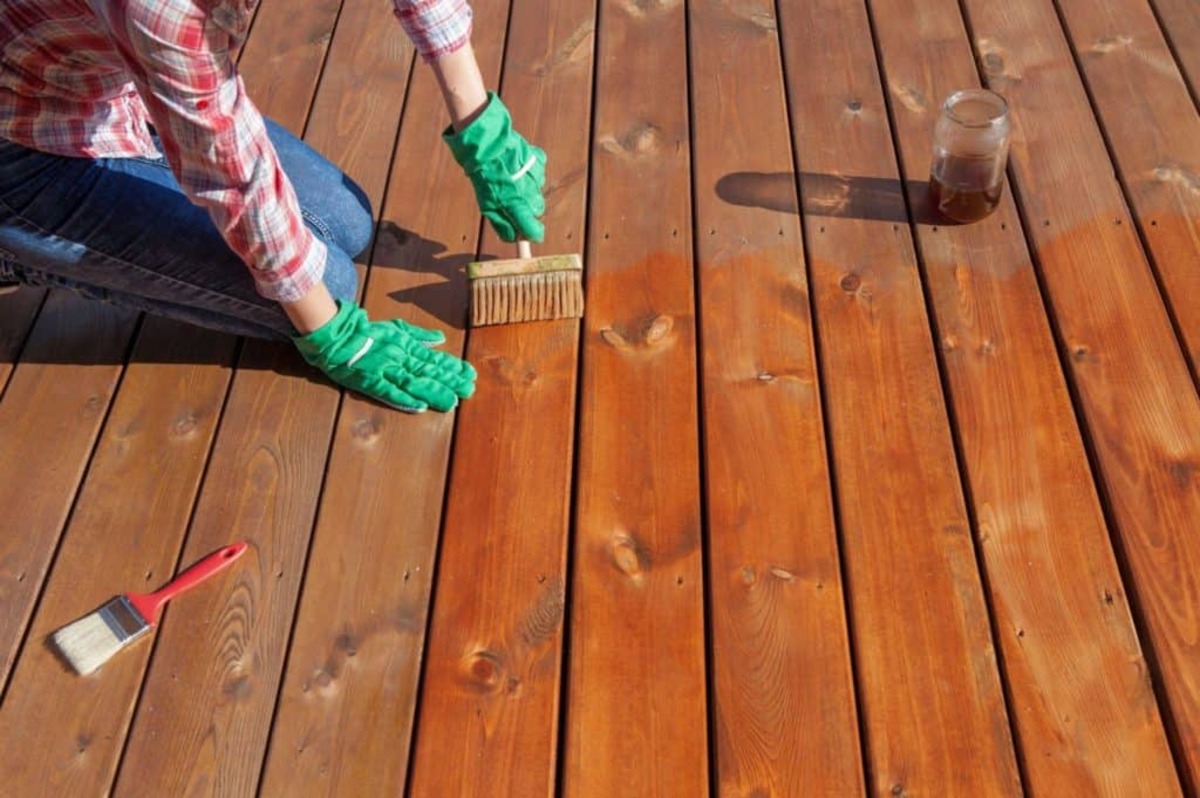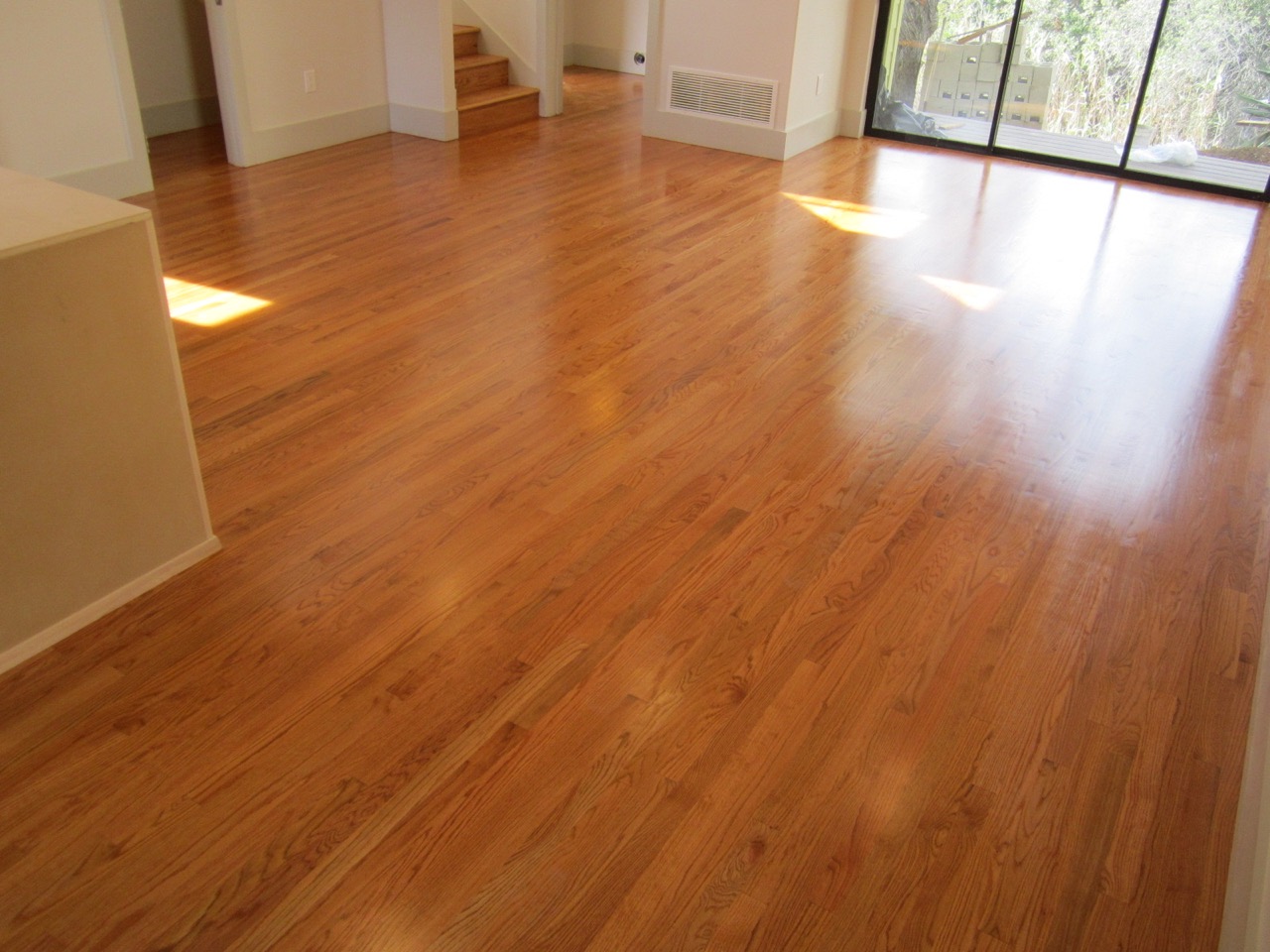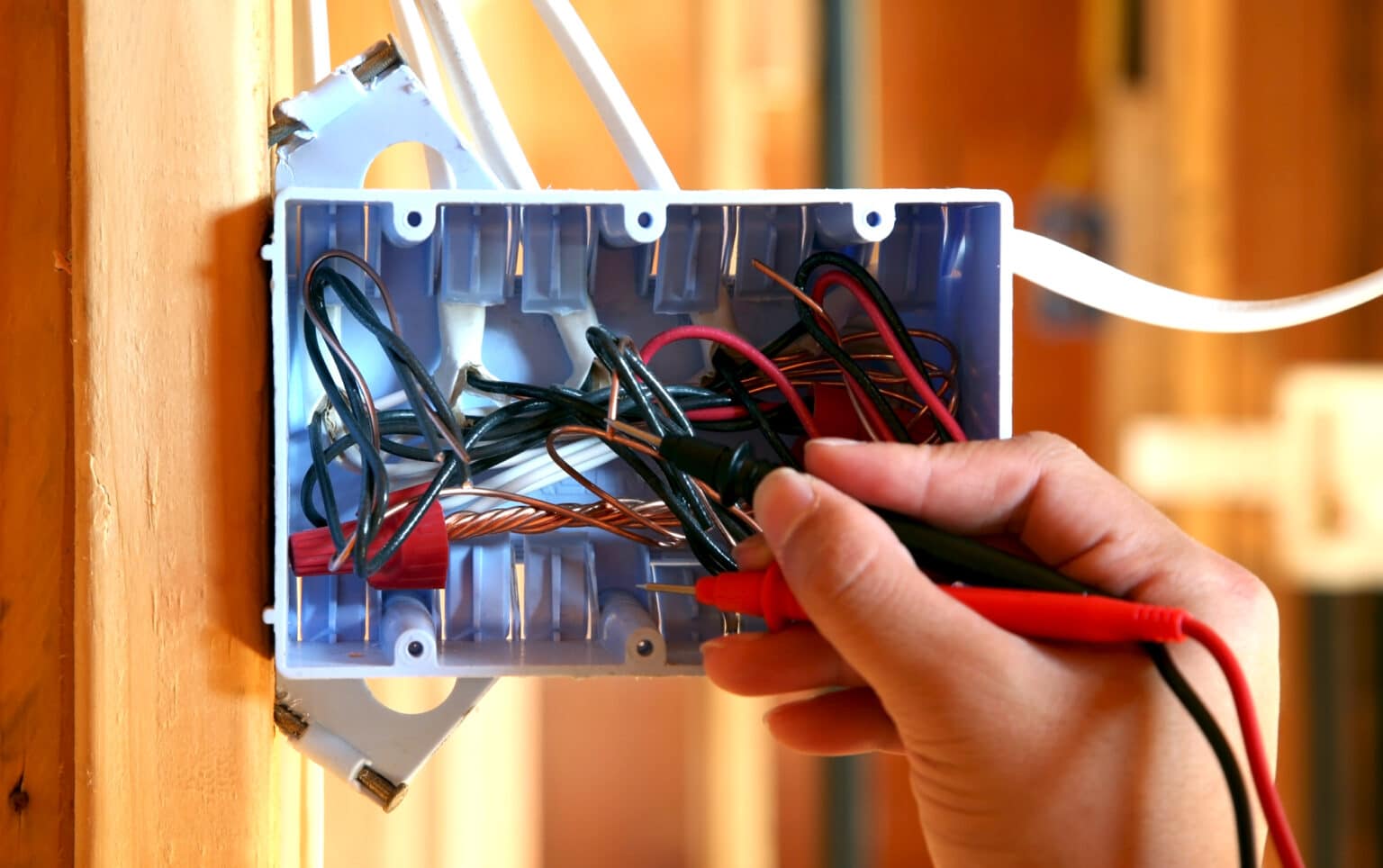

Articles
What To Know About Sealing A Deck
Modified: January 6, 2024
Discover everything you need to know about sealing your deck with our informative articles. Ensure its longevity and preserve its beauty with our expert tips.
(Many of the links in this article redirect to a specific reviewed product. Your purchase of these products through affiliate links helps to generate commission for Storables.com, at no extra cost. Learn more)
Introduction
Welcome to the ultimate guide on sealing your deck! If you are a homeowner with a deck, you likely know how important it is to maintain and protect this outdoor space. One of the most effective ways to preserve your deck and prolong its lifespan is by sealing it.
Sealing a deck involves applying a protective coating to the wood surface, creating a barrier against moisture, UV damage, and other elements that can cause deterioration. This not only enhances the overall appearance of your deck but also prevents common issues such as rotting, warping, and fading.
In this comprehensive article, we will explore the reasons why you should seal your deck, the different types of deck sealers available, the necessary preparation before sealing, and a step-by-step guide to help you through the sealing process. We will also share some tips for success and common mistakes to avoid. Finally, we will discuss the frequency at which you should seal your deck and the signs that indicate your deck is in need of sealing.
Whether you are a seasoned DIY enthusiast or new to deck maintenance, this guide is designed to provide you with all the information you need to seal your deck effectively. So, let’s dive in!
Key Takeaways:
- Sealing your deck is crucial for protecting it from moisture, UV damage, and mold, enhancing its durability and lifespan. Proper preparation, choosing the right sealer, and regular maintenance are key to a successful sealing process.
- Regularly inspect your deck for signs that indicate the need for resealing, such as lack of water repellency, faded color, and increased wood porosity. By addressing these signs promptly, you can maintain the beauty and integrity of your deck.
Reasons to Seal a Deck
Sealing your deck offers numerous benefits that go beyond just the aesthetics. Here are some compelling reasons why sealing a deck is crucial:
- Protection against moisture: One of the primary reasons to seal a deck is to protect it from moisture damage. Rain, snow, and humidity can penetrate the wood surface, causing it to expand, contract, and eventually rot. Sealing creates a waterproof barrier, preventing water from seeping into the wood and keeping it structurally sound.
- UV damage prevention: Constant exposure to sunlight can cause deck boards to fade, discolor, and become brittle. UV rays also break down wood fibers, leading to cracking and splintering. A quality deck sealer contains UV inhibitors that block harmful rays and help maintain the natural color and integrity of the wood.
- Resistance to mold and mildew: Unsealed decks are more prone to mold and mildew growth, especially in damp and shaded areas. These fungal growths not only mar the appearance of your deck but can also pose health risks. Sealing the deck inhibits the growth of mold and mildew, making it easier to maintain a clean and healthy outdoor space.
- Enhanced durability: Sealing creates a protective barrier that shields the wood from everyday wear and tear. It prevents the penetration of dirt, stains, and spills, making your deck more resilient against foot traffic, furniture, and other potential sources of damage.
- Longer lifespan: By sealing your deck, you are significantly extending its lifespan. By reducing the effects of moisture, UV rays, mold, and general wear and tear, you are essentially investing in the long-term durability and longevity of your deck.
Sealing your deck is an essential step in its maintenance routine. It not only protects your investment but also ensures that you can enjoy a beautiful, functional, and safe outdoor space for years to come.
Types of Deck Sealers
When it comes to choosing a deck sealer, there are several options available, each with its own set of advantages and considerations. Here are the main types of deck sealers to help you make an informed decision:
- Clear Sealers: Clear sealers provide a natural look and are ideal for preserving the natural beauty of the wood. They offer minimal color enhancement and protection against moisture and UV rays. Clear sealers are best suited for newer, unweathered decks.
- Tinted Sealers: Tinted sealers add a subtle color to the wood while still allowing the grain to show through. They provide enhanced UV protection and help to hide minor imperfections in older decks. Tinted sealers are available in a variety of shades to complement your desired aesthetic.
- Semi-Transparent Stains: Semi-transparent stains provide a richer color while still allowing the natural grain of the wood to show through. They provide moderate UV protection and are suitable for both old and new decks. Semi-transparent stains are a popular choice for their balance between color enhancement and wood preservation.
- Solid Stains: Solid stains offer the most dramatic color transformation for your deck. They provide excellent protection against UV rays and moisture and can also hide significant imperfections and aging on older decks. Solid stains offer a wide range of opaque colors and are typically recommended for previously stained or weathered decks.
- Deck Paints: Deck paints are the most opaque option, effectively concealing the wood grain. They provide maximum protection against UV rays, moisture, and foot traffic. However, they may require more maintenance over time, as deck paints can peel and chip with wear. Deck paints are a suitable choice if you prefer a solid, uniform finish and are willing to invest in regular upkeep.
It’s important to consider factors such as the age and condition of your deck, desired level of color enhancement, and long-term maintenance requirements when choosing the right type of deck sealer. It’s always recommended to follow the manufacturer’s instructions and consult with professionals if you’re unsure about which sealer best fits your specific deck needs.
Preparation Before Sealing
Proper preparation is key to achieving a successful and long-lasting deck sealing outcome. Before you start applying the sealer, make sure to follow these essential steps:
- Clean the deck: Remove any dirt, debris, and stains from the deck surface. Sweep the area thoroughly to get rid of loose dirt, leaves, and twigs. Use a deck cleaner or mild detergent mixed with water to scrub away any grime or mold. Rinse the deck with clean water and allow it to dry completely before proceeding.
- Repair damaged areas: Inspect the deck for any damaged or rotten boards, loose nails or screws, and splintering wood. Replace or repair any damaged sections to ensure a solid and safe foundation before sealing.
- Sand the deck: If your deck has a rough or weathered surface, consider sanding it to create a smoother finish. Sanding will help the sealer adhere better to the wood and ensure an even application. Use a medium-grit sandpaper and sand in the direction of the wood grain.
- Protect surrounding areas: Cover any nearby plants, shrubs, and surfaces that you want to avoid getting sealer on. Use plastic tarps or drop cloths to protect your landscaping and any adjacent structures.
- Check the weather: It’s essential to choose a day with ideal weather conditions for sealing your deck. Avoid sealing on extremely hot or humid days, as the sealer may not dry properly. Check the forecast and choose a mild, dry day with temperatures between 50°F (10°C) and 90°F (32°C).
By thoroughly cleaning, repairing, and preparing your deck, you ensure that the sealer will adhere effectively and provide maximum protection. Taking the time to prepare your deck will contribute to a seamless and beautiful sealing process.
Step-by-Step Guide to Sealing a Deck
Sealing your deck is a relatively straightforward process. Follow these step-by-step instructions to ensure a successful sealing project:
- Gather your materials: Before you begin, gather all the necessary materials, including the deck sealer of your choice, a paint roller or brush, a paint tray, and a paintbrush or roller handle extension for hard-to-reach areas.
- Prepare the sealer: If using a tinted sealer or stain, mix the sealer thoroughly according to the manufacturer’s instructions. Make sure to follow any specific guidelines for tinting or shaking the product.
- Start with the deck boards: Begin by sealing the top surface of each deck board. Dip the roller or brush into the sealer, removing any excess, and apply a thin, even coat of sealer. Work in small sections, typically 2-3 boards at a time, and ensure that the sealer is evenly distributed.
- Move to the railings and spindles: After sealing the deck boards, move on to the railings and spindles. Use a paintbrush or a smaller roller to apply the sealer to these areas. Pay attention to any cracks, crevices, or hard-to-reach spots and ensure they are adequately covered.
- Apply a second coat (if needed): Depending on the type of sealer and the desired level of protection, you may need to apply a second coat. Allow the first coat to dry completely, following the recommended drying time on the product label, before applying the second coat. This will ensure maximum durability and protection.
- Clean up: Once you have finished sealing your deck, clean your tools and dispose of any leftover sealer or staining materials properly. Follow your local regulations for the disposal of paint-related products.
- Allow ample drying time: After sealing your deck, it’s important to allow sufficient drying time. Avoid foot traffic, furniture placement, or any other activities on the deck until it has fully dried according to the manufacturer’s instructions.
Following this step-by-step guide will help you seal your deck effectively and achieve a professional-looking finish. Remember to always refer to the specific instructions provided by the manufacturer, as different sealers may have their own application guidelines.
When sealing a deck, make sure to thoroughly clean and dry the surface before applying the sealant. This will ensure better adhesion and a longer-lasting finish.
Read more: What To Know About Building A House
Tips for Success
Sealing a deck can be a straightforward process, but incorporating these tips will ensure a successful outcome and help you achieve the best results:
- Choose the right sealer: Select a high-quality sealer that is specifically designed for use on decks. Consider the type of wood, the climate in your area, and the desired level of protection and aesthetics when choosing the sealer that best fits your needs.
- Read and follow the instructions: Be sure to thoroughly read and understand the instructions provided by the manufacturer. Follow the recommended application methods, drying times, and safety precautions for the specific sealer you are using.
- Test the sealer: Before applying the sealer to the entire deck, perform a small test in an inconspicuous area. This will help you determine if you are satisfied with the color and finish of the sealer before committing to the entire deck.
- Apply thin, even coats: It’s better to apply multiple thin coats of sealer rather than one thick coat. This allows for better absorption and ensures a smoother, more consistent finish. Avoid over-applying the sealer, as it may result in a sticky or tacky surface.
- Consider the weather: Choose a day with ideal weather conditions for sealing your deck. Avoid sealing in direct sunlight or extreme heat, as it can cause the sealer to dry too quickly, potentially leading to an uneven finish. Also, check the humidity levels, as high humidity can affect the drying process.
- Protect yourself: When working with deck sealers, always wear protective gear, including gloves, safety glasses, and a mask or respirator. This will shield you from potential skin and eye irritation, as well as harmful fumes.
- Maintain your deck: Regular deck maintenance is key to preserving the longevity of your sealer. Sweep off debris regularly, clean up spills promptly, and inspect your deck for any signs of wear or damage. Touch up or reapply the sealer as needed to maintain its protective qualities.
By following these tips, you can ensure a successful deck sealing experience and enjoy a beautifully protected deck for years to come. Remember, proper preparation, careful application, and ongoing maintenance are key to maintaining the integrity and appearance of your deck.
Common Mistakes to Avoid
While sealing a deck is a relatively straightforward process, there are some common mistakes that can impact the effectiveness and appearance of the sealer. Here are a few mistakes to avoid:
- Skipping the preparation: Failing to properly clean and prepare the deck before sealing is a common mistake. Make sure to thoroughly clean the surface, repair any damaged areas, and allow it to dry completely. Skipping this step can prevent the sealer from adhering properly and result in an uneven finish.
- Overapplying the sealer: Applying too much sealer in a single coat can lead to an uneven and sticky finish. It’s important to follow the manufacturer’s instructions and apply thin and even coats. Overapplying can also prevent the sealer from fully penetrating the wood and compromise its effectiveness.
- Sealing a damp deck: Sealing a deck that has not completely dried from rain or cleaning is a common mistake. Moisture trapped beneath the sealer can cause peeling, bubbling, or a hazy appearance. Allow ample drying time before applying the sealer to ensure optimal results.
- Sealing in extreme weather conditions: Sealing a deck in extreme hot or cold weather can affect the drying process and the overall quality of the sealer. Avoid sealing on excessively hot or cold days, as it may lead to poor adhesion and drying issues.
- Not applying a second coat (if recommended): Some sealers require a second coat for optimal protection. Failing to apply a second coat when recommended by the manufacturer can leave your deck vulnerable to moisture and UV damage. Be sure to check the sealer’s instructions and apply the recommended number of coats.
- Ignoring maintenance: Once you have sealed your deck, proper maintenance is essential to protect your investment. Neglecting regular cleaning, sweeping off debris, and addressing any issues can result in the sealer wearing off prematurely and the wood becoming more susceptible to damage.
By avoiding these common mistakes, you can ensure a successful deck sealing project and prolong the life of your deck. Take the time to do proper preparation, follow the manufacturer’s instructions, and maintain your deck regularly to enjoy a beautiful and well-protected outdoor space.
How Often Should a Deck be Sealed?
The frequency at which you should seal your deck depends on several factors, including the type of wood, climate conditions, and the quality of the previous sealer. As a general guideline, most experts recommend sealing a deck every 1 to 3 years. However, it’s essential to evaluate your specific deck’s needs to determine the best timeline for resealing.
Here are some factors to consider when deciding how often to seal your deck:
- Wood type: Different types of wood have varying levels of natural durability. Hardwoods like cedar and redwood are naturally more resistant to decay and may require less frequent sealing. Softer woods, such as pine or spruce, may need more regular sealing to ensure long-term protection.
- Exposure to the elements: Decks exposed to extreme weather conditions, including heavy rainfall, snow, prolonged sun exposure, or high humidity, may require more frequent sealing. These environmental factors can accelerate the wear and tear of the sealer, necessitating reapplication sooner.
- Deck usage: The amount of foot traffic, furniture placement, and regular use of your deck can impact the wear of the sealer. If you frequently host gatherings, have children or pets playing on the deck, or regularly move heavy furniture, it may be necessary to reseal more often to maintain optimal protection.
- Quality of previous sealer: If you have previously applied a high-quality sealer and properly maintained your deck, the sealer’s effectiveness may last longer. However, if you notice signs of wear, such as fading, water absorption, or diminished protection, it’s time to reseal, regardless of the timeframe.
Regular inspection of your deck is crucial in determining when it needs to be sealed. Look for signs such as water beading, lack of color vibrancy, or wood becoming more absorbent. Additionally, if you notice fading or graying, it may indicate that the deck is no longer adequately protected and should be sealed.
Ultimately, the best practice is to follow the manufacturer’s recommendations for the specific sealer you are using. They will provide guidance on the expected lifespan of the sealer and the recommended timeframe for reapplication.
By staying proactive and regularly monitoring the condition of your deck, you can ensure that it receives the necessary sealing treatments to maintain its beauty, durability, and protection against the elements.
Signs That Your Deck Needs Sealing
Regularly inspecting your deck for signs of wear and tear is essential to know when it’s time to reseal. Here are some common signs that indicate your deck is in need of sealing:
- Lack of water repellency: If water applied to your deck no longer beads up and instead soaks into the wood, it’s a clear indication that the previous sealer has worn off and your deck is vulnerable to moisture damage. Water should easily roll off the surface of a properly sealed deck.
- Faded color: Over time, UV rays can cause the color of your deck to fade or become dull. If you notice a significant loss of color vibrancy or a greyish appearance, it indicates that the UV protection of the sealer has diminished, and it’s time to reseal.
- Wood becoming more absorbent: If your deck seems to be absorbing water more easily or feels softer than usual, it’s a sign that the wood is no longer adequately protected. Increased wood porosity indicates that the sealer has lost its effectiveness and should be reapplied.
- Visible signs of damage: Check your deck for any visible signs of damage, such as cracks, splintering, or warping. These issues can arise from exposure to moisture and weather elements. Resealing the deck can help prevent further deterioration and restore its structural integrity.
- Mold or mildew growth: If you notice the growth of mold or mildew on your deck, it’s a sign that moisture is penetrating the wood surface. A properly sealed deck should inhibit the growth of mold and mildew, so if they are present, it’s an indication that the sealer needs to be refreshed.
- Increased maintenance: If you find yourself needing to clean and maintain your deck more frequently, it may be a sign that the sealer is wearing off. A well-sealed deck should require minimal maintenance, so an increase in cleaning efforts suggests that it’s time to reseal.
Remember, proactive maintenance and regular inspections are key to identifying when your deck needs to be sealed. By promptly addressing any of these signs and resealing your deck as needed, you can protect its longevity, beauty, and structural integrity.
Conclusion
Sealing your deck is an essential step in its maintenance and protection. By creating a barrier against moisture, UV rays, and other elements, a quality deck sealer enhances the longevity, durability, and overall appearance of your outdoor space.
In this comprehensive guide, we’ve covered the reasons why you should seal your deck, the different types of deck sealers available, the necessary preparation before sealing, and a step-by-step guide to help you through the sealing process. We’ve also provided tips for success, common mistakes to avoid, and guidance on how often to seal your deck.
Remember, proper preparation, selecting the right sealer, and following the manufacturer’s instructions are imperative for achieving optimal results. Regular inspections and addressing signs of wear and tear will help you determine when it’s time to reseal your deck, ensuring its continued protection and longevity.
By investing the time and effort to seal your deck correctly, you’re not only enhancing its visual appeal but also protecting it from moisture damage, UV rays, mold, and general wear and tear. A well-maintained deck will provide you with a beautiful outdoor space to enjoy for years to come.
So, go ahead and start the process of sealing your deck – you’ll be rewarded with a stunning, well-protected deck that you can enjoy and be proud of.
Frequently Asked Questions about What To Know About Sealing A Deck
Was this page helpful?
At Storables.com, we guarantee accurate and reliable information. Our content, validated by Expert Board Contributors, is crafted following stringent Editorial Policies. We're committed to providing you with well-researched, expert-backed insights for all your informational needs.














0 thoughts on “What To Know About Sealing A Deck”